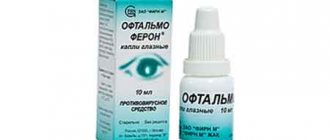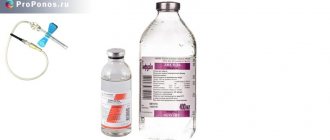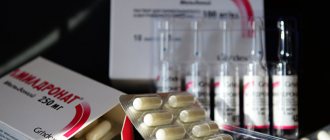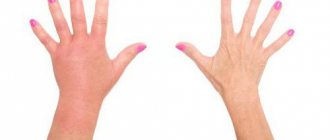Riboxin is one of the drugs that stimulates energy metabolism in cells. This is an effective remedy for various cardiac pathologies, as well as for diseases of the gastrointestinal tract and liver. It strengthens the heart muscle, normalizes blood flow in the coronary vessels and, in general, has a positive effect on human health.
Pharmacological properties of the drug Riboxin
Pharmacodynamics. Riboxin is an anabolic drug that has antihypoxic and antiarrhythmic effects. It is a precursor of ATP, is directly involved in glucose metabolism and promotes metabolism activation under hypoxic conditions and in the absence of ATP. The drug activates the metabolism of pyruvic acid to ensure the normal process of tissue respiration and promotes the activation of xanthine dehydrogenase. Riboxin has a positive effect on metabolism in the myocardium, in particular, it increases the energy balance of cells, stimulates the synthesis of nucleotides, and increases the activity of a number of Krebs cycle enzymes. The drug normalizes the contractile activity of the myocardium and promotes more complete relaxation of the myocardium in diastole due to the ability to bind calcium ions that penetrate into cells during their excitation, and activates tissue regeneration (especially the myocardium and the mucous membrane of the digestive tract). Pharmacokinetics. When administered intravenously, Riboxin is quickly distributed in tissues, metabolized in the liver, where it is completely utilized in the biochemical reactions of the body. It is excreted mainly in urine.
Overdose, special instructions, interaction
No cases of drug overdose were identified. During the period of taking the drug, monitoring of uric acid levels in the blood and urine is required. Driving is not prohibited during Riboxin therapy. The drug is approved for work requiring particularly high concentration.
Information for patients suffering from diabetes: one tablet is comparable to 0.00641 bread units.
There may be interactions with medications from other groups developed for the treatment of cardiac pathologies. Inosine enhances the effect of heparin, since it itself affects platelet accumulation, as well as the inotropic effect of glycosides on the heart.
It is possible to take Riboxin simultaneously with drugs from the group of beta blockers. Combinations of inosine with furosemide, nitroglycerin, and nifedipine are allowed. It is prohibited to use inosine in the same syringe with acids, derivatives of heavy metals, and pyridoxine. Also, you should not combine the described medicine with alkaloids, mix with solvents other than glucose and
Indications for use of the drug Riboxin
Complex treatment of coronary artery disease (condition after myocardial infarction, angina pectoris), heart rhythm disturbances caused by the use of cardiac glycosides, treatment of cardiomyopathies of various origins, myocarditis (due to physical overload), liver diseases (hepatitis, cirrhosis of the liver, fatty liver), urocoproporphyria; prevention of leukopenia during irradiation. As a means of improving visual function, Riboxin is used for open-angle glaucoma with normalized (with the help of antihypertensive drugs) intraocular pressure.
Treatment during lactation, pregnancy
Prescribing Riboxin to pregnant and lactating women is not prohibited. The contraindications noted in the instructions only indicate that no research has been conducted in this area. However, today there is quite a lot of positive experience in using the drug during pregnancy and breastfeeding.
The drug is an effective antioxidant and antihypoxic agent and helps normalize metabolic processes. Riboxin helps against hypoxia that develops against the background of oxygen starvation, which is very important during the period of fetal growth.
Sometimes inosine is given during childbirth to reduce the strain on the heart. It is possible to prescribe the drug for the treatment of liver pathologies and gastritis in a pregnant woman.
If the patient tolerates the drug well, a course of treatment is prescribed for one month, one tablet 3-4 times a day. However, despite the safety of the medicine, the decision to treat with Riboxin should be made by the treating doctor on an individual basis.
Use of the drug Riboxin
Tablets: orally before meals in a daily dose of 0.6–2.4 g. For the first time, take 0.6–0.8 g/day (0.2 g 3–4 times a day), and if well tolerated, increase the dose for 2–3 days up to 1.2 g/day in 3 divided doses and up to 2.4 g/day. The course of treatment lasts from 4 weeks to 1.5–3 months. For urocoproporphyria, Riboxin is taken in a daily dose of 0.8 g (0.2 g 4 times a day) daily for 1–3 months. Injection. Adults and older children are prescribed intravenous drip or bolus. Initially, 200 mg (10 ml of 2% solution) is administered once a day, then, if well tolerated, up to 400 mg (20 ml of 2% solution) 1–2 times a day. The course of treatment is determined individually (on average 10–15 days). When administered drip into a vein, 2% solution of the drug is diluted in 5% solution of glucose or isotonic solution of sodium chloride (up to 250 ml). The drug is administered slowly, 40–60 drops per minute. In case of acute cardiac arrhythmias, jet administration in a single dose of 200–400 mg (10–20 ml of 2% solution) is possible.
Analogues and substitutes
The modern pharmaceutical market offers the patient a list of drug analogs that differ in appearance and price:
- tablet forms: Riboxin Avexima, Riboxin-Lect, Ribonosine;
- injection solution: Inosie-F, Inosin-Eskom.
If there are contraindications to Riboxin, for complex therapy of the underlying disease it is recommended to select a substitute with a similar effect.
The metabolic agents most used in cardiological practice are:
Panangin, Asparkam - drugs with a high potassium content, which is prescribed to patients with rhythm and conduction disorders;- Trimetazidine (Preductal) – corrects metabolic processes at the cellular level, eliminates the harmful effects of free radicals (under-oxidized metabolites), enhances the compensatory capabilities of the heart;
- Antioxidants (inhibit the processes of free radical oxidation in cells): vitamins A, E, C, selenium and zinc preparations;
- Adenosine triphosphate is a direct form of the ATP molecule, which is most often used to stop attacks of supraventricular tachycardia. The second generation is ATP-long with prolonged action.
The selection of funds is carried out depending on individual sensitivity, the presence of additional signs of vitamin or micronutrient deficiency in the patient.
Causes of blood thickening
The substance becomes viscous for many reasons, the main ones are listed and described below.
Water shortage
The list of foods that increase plasma fluidity can start with vegetables that have thinning properties. This category includes:
- Bell pepper.
- Beet.
- Cucumbers.
- Tomatoes.
- Cabbage.
Ripe tomatoes contain lycopene, a substance that prevents red blood cells from sticking together. Some fruits also prevent the formation of blood clots:
- Citrus.
- Cherry.
- Peaches.
- Apples.
Their pulp contains a lot of useful microelements. Berries are also able to adjust the composition of the blood towards dilution. The best people to cope with this task are:
- strawberries;
- figs;
- blueberry;
- blackberry;
- grape;
- viburnum;
- strawberry;
- raspberries.
Juices made from apricots, currants, peaches, beets, apples, as well as cranberries, tomatoes, and celery are also useful.
Bee products
Honey and propolis are the strongest regulators of recovery processes in the human body, including normalization of the composition and physical properties of the liquid medium.
Herbs and spices
Red hot peppers and onions are rich in antioxidants and allicin, which is responsible for lowering bad cholesterol levels. Garlic is also used to thin the blood. It is also useful for hypertension. You can eat the vegetable in any form: fresh or dried.
They also reduce blood viscosity:
- Chocolate, cocoa, coffee.
- Vegetable oils.
- Seafood, kelp.
- Thyme, oregano, mint.
- Sprouted wheat, melon.
It is possible to avoid red blood cell clumping with the anticoagulants DHA and EPA from fish oil. With their help, they achieve improved rheological characteristics and prevent thrombosis in the heart and blood vessels.
Ginger, which affects cholesterol levels, also improves blood circulation. It can be added to tea along with lemon, honey, cinnamon. But the most accessible product is plain water. It cleanses the blood every minute. Its consumption rate is 30 ml per 1 kg of weight, but this does not include teas, soups, compotes, and juices.
Side effects
As a rule, the medicine is well tolerated, only in isolated cases the following side effects are observed:
- Arterial hypotension;
- Increased levels of uric acid and its salts in the blood;
- Tachycardia;
- Itchy skin;
- General weakness;
- Exacerbation of gout;
- Urticaria of allergic origin;
- Redness of the skin.
When is blood thinning required?
Blood consists of plasma and formed elements. Their ratio is called the hematocrit number. The values of this indicator increase if the blood thickens. Such a substance is difficult to pump, so the heart wears out prematurely. It tends to form blood clots and is poorly pushed through the capillaries.
Hematocrit is determined in the laboratory. Using high numbers, the doctor identifies the causes and prescribes treatment for hyperviscose syndrome. This helps the patient get rid of a number of serious pathologies, including atherosclerosis.
The official information is this: in men, hematocrit is diagnosed 10 times more often. In women, fat is deposited under the skin, and in the stronger sex in the form of plaques on the walls of blood vessels. The situation is worsened by bad habits, overeating, stress, and hypertension. During nervous overload, the released hormone adrenaline constricts the altered blood vessels, which leads to a heart attack.
Symptoms of thickening of the body fluid include:
- Heaviness in the legs.
- Memory impairment.
- Drowsiness.
- Absent-mindedness.
- Fast fatiguability.
Release form
Riboxin is produced in the form:
- Double-layer tablets. The biconvex tablets with a yellow or yellow-orange coating have a rough surface. Under the shell there is a white core. The tablets are sealed in blisters of 10 pieces. 1-5 blisters are placed in one pack.
- Solution for injection (two percent). The volume of each ampoule is 10 ml. 10 ampoules are placed in a cardboard box.
- Capsules. 20, 30 or 50 capsules are packaged in cardboard boxes.
What you can't eat
Having included healthy and most effective foods for reducing blood viscosity in your daily menu, you must at the same time give up harmful ones. These include, first of all, fatty foods.
- Any animal fat
, as well as cream and butter from them, increases cholesterol levels and blood viscosity. Soups with rich broth and pork for main course are prohibited. - and a variety of confectionery products are also contraindicated. An excess of fast carbohydrates increases blood concentration and also contributes to the development of diabetes and obesity. Therefore, you will have to replace your favorite buns, pastries, cakes and white bread with fruits from the list above, and add honey to your tea instead of sugar.
- You will also have to give up tempting sausages, smoked meats, pickled and canned products
. - It is not recommended to eat lentils, potatoes, walnuts, bananas and mangoes
. They contain a lot of vitamin K, which increases blood clotting. - Alcohol
should be completely eliminated from the diet. There is an opinion that a glass of dry red wine a day will only bring benefits, but most doctors recommend refraining from drinking any alcoholic beverages. In addition, high-quality wine is quite an expensive pleasure, and cheap wines are contraindicated even for completely healthy people.
Prohibited foods for thick blood
Along with products that help improve blood quality, there are also those that aggravate the situation. To avoid serious consequences, their use should be kept to a minimum.
Products that increase the risk of thrombosis include:
- sugar;
- pork and lard;
- buckwheat grain;
- mango;
- baking and baked goods;
- potato;
- candies;
- coffee;
- any sausages;
- smoked and pickled foods;
- walnuts and peanuts;
- mutton;
- canned food;
- high fat dairy products;
- carbonated drinks;
- goose meat;
- bananas;
- beans and lentils.
Drinking alcohol and smoking are very harmful to the vascular system and hematopoiesis.
In addition, some herbs can cause blood to thicken. Among them:
- St. John's wort;
- yarrow;
- chokeberry;
- valerian;
- corn silk;
- nettle.
Infusions and decoctions from them can be used for course treatment, but under no circumstances should you drink them constantly.
The blood density indicator is easy to correct. To do this, it is enough to follow simple recommendations for organizing nutrition, walk more in the fresh air and give up bad habits. Medicinal herbs will enhance the effect, and proper medical monitoring will help to notice the problem in time and solve it without serious health consequences.
Thrombosis is a serious disease accompanied by the formation of blood clots in blood vessels. The clot can break off and get into the organ, which will cause trouble. The main treatment consists of taking medications and blood thinning products.
To prevent the disease from intensifying, it is important to remember preventive measures and begin treatment at the first symptoms.
Proper nutrition is necessary to prevent disease. It is worth making a habit of drinking a lot of water. The average daily fluid intake per person is three liters in hot weather, two in cold weather. Spicy, fried foods should be excluded from the diet - they contribute to the formation of cholesterol in the blood, this becomes the main reason for blockage of the veins.
What thins the blood and removes thrombosis:
Doctors do not exclude other products from consumption. Meat and fish are required. If you choose meat products, poultry and beef are suitable. Pork can be added to food in small pieces; it is better to opt for lean parts. To thin the blood, you should eat fish. Herring and varieties of red fish are suitable; seafood products are considered healthy.
Steam the products, do not fry them too much, lightly fry them over a fire for taste. You are allowed to drink a little red wine every day before meals - it thins the blood and improves blood circulation. Other alcoholic products are prohibited, especially beer and vodka, which dilate blood vessels for a while and will worsen the patient’s condition, are not recommended.
When to thin the blood
Many people see nothing wrong with blood thickening. But this process can cause serious consequences for the body. The concept of “thick blood” does not belong to the category of scientific terms. Excessive viscosity in medical language is called hyperviscose syndrome and is accompanied by the following processes:
- increase in the number of red blood cells;
- an increase in hemoglobin containing iron and proteins;
- violation of the ratio of blood elements to plasma (hematocrit).
Such deviations are established using laboratory testing. At the same time, standard viscosity indicators differ in different age groups. In adults they look like this:
- relative density from 1048 to 1066;
- the viscosity of whole blood in relation to water (the indicator of which is taken as one) is acceptable within the range from 4.0 to 5.5;
- ratio of the specific gravity of erythrocytes to plasma density: 1.092–1.095 to 1.024–1.050;
- according to hematocrit, the norm for men is 40–54%, for women – 37–47%.
A baby's blood is thick and in terms of indicators is very different from adult norms. On the first day of life, the content of red blood cells in the newborn’s body can be more than 5.5 T/l. Hemoglobin – from 160 to 200 g/l. After a few days, the data changes downward.
Such test results do not indicate any pathology. It’s just that in the first few days the child undergoes adaptation to the environment and adapts to independent breathing. Blood counts adjust to adult norms towards the end of the first year of life.
For the body to function properly, blood density must fall within the designated norms. Its decrease accelerates blood flow, while thickening, on the contrary, slows it down. This can cause the development of pathologies of the heart and blood vessels.
Blood thinning is necessary for people who have already been diagnosed with the following diseases:
- heart attack;
- ischemia of the heart or brain;
- varicose veins;
- thrombophlebitis;
- stroke;
- diabetes;
- leukemia;
- cirrhosis of the liver;
- poisoning accompanied by dehydration due to diarrhea or vomiting;
- pathologies of the adrenal glands;
- thrombosis;
- hepatitis;
- pancreatitis.
Attention! For such diseases, blood must be tested annually to avoid complications.
Blood viscosity should also be monitored by those who suffer from diseases that lead to an increase in the content of proteins and red blood cells, people over 45 years of age, as well as those who take hormonal oral contraceptives. If you take timely measures aimed at thinning the blood, you can prevent most of the above pathologies.
You should be wary if symptoms such as:
- headaches;
- constant fatigue;
- numbness (or tingling) in the limbs.
These manifestations may be periodic (for example, with dehydration) and disappear after recovery. Otherwise, you should consult a doctor and donate blood. This will help start treatment. It depends on what causes the excess blood viscosity.
The functioning of all internal organs depends on the state of the coagulation system. The quality of the blood must be closely monitored and the factors leading to its thickening taken into account.
The main ones:
- lack of essential substances (lecithin, vitamin C, zinc). This is often associated with liver dysfunction;
- poor ecology in the region of residence or work, including exposure to radiation;
- quality of drinking water, especially negatively affected by pollution, chlorination, carbonation;
- excessive consumption of caffeinated drinks, which remove water;
- hot climate;
- lack of enzymes, which leads to the penetration of incompletely broken down proteins and lipids into the circulatory system;
- inflammation in the intestines;
- excessive physical activity;
- violation of water metabolism (when the absorption of incoming fluid occurs in the large intestine).
Attention! Blood may become thicker if there is not enough salt.
Incorrect eating habits also lead to problems. Those who love fatty foods, sugar, fast carbohydrates and preservatives are at risk - these foods cause the formation of cholesterol plaques. At the same time, there are a number of products that help reduce the negative impact on the blood system.
Compound
1 tablet of the pharmaceutical product contains:
- Riboxin – 0.2 g;
- Calcium stearate;
- Potato starch;
- Powdered sugar;
- Opadry II Yellow coating mixture - Indigo carmine (E 132), Lactose monohydrate, Titanium dioxide (E 171), Macrogol (polyethylene glycol 3000), Quinoline yellow (E 104), Iron oxide (E 172).
Composition of solution for injection:
- inosine – 20 mg/ml.
Who needs this information
The reasons why the composition of the blood changes are quite numerous. The increase in the activity of the coagulation system is influenced by hormonal and age-related changes, taking specific medications and, of course, poor nutrition. You should pay attention to your diet when:
- varicose veins and thrombophlebitis;
- diagnosed ischemic disease of the brain and heart;
- vascular atherosclerosis (especially obliterating, which can lead to gangrene and amputation of the legs);
- obesity;
- diabetes mellitus;
- increased coagulation rates during pregnancy;
- taking oral contraceptives;
- excessive consumption of fatty and sweet foods, as well as carbonated drinks and alcohol;
- hereditary and acquired blood diseases (thrombocytosis, erythremia);
- pathologies of the pancreas and liver.
In addition, a simple lack of fluid in the body can increase the thickness of the blood. This condition occurs when dehydration occurs due to vomiting or diarrhea, as well as insufficient daily intake of water and other drinks.
Important! Age-related changes in the blood inevitably begin after 40 years. Women and overweight people are most at risk.









